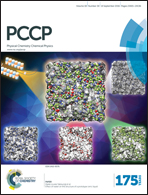The peculiar behavior of the molecular dynamics of a glass-forming liquid confined in native porous materials – the role of negative pressure†
Abstract
In this paper, we combine Broadband Dielectric Spectroscopy (BDS) at ambient and high pressure, and positron annihilation lifetime spectroscopy (PALS) data of 2-ethylhexanol in the bulk state and when infiltrated in native silica nanopores to elucidate the relative role of surface effects on the Debye and structural relaxation processes under 2D spatial constraints. We show that the two processes have different sensitivities to (i) the changes in density as quantified by the EV/Hp ratio and (ii) the degree of confinement. Significant enhancement of the dynamics of the confined molecules at low temperatures is related to the vitrification of the interfacial molecules (Tg,int) affecting the packing density of the core molecules. This is corroborated by the PALS measurements, which demonstrated that the effective volume for the confined samples is slightly higher and seems to be temperature invariant below Tg,int. Consequently, negative pressure systematically develops with lowering temperature reaching values of −100 and −110 MPa (depending on the pore size) at the glass transition temperature. This result offers a better understanding of the counterbalance between surface and finite size effects as well as the role of negative pressure in controlling the dynamics and the glass transition of liquids under 2D spatial restrictions.


 Please wait while we load your content...
Please wait while we load your content...